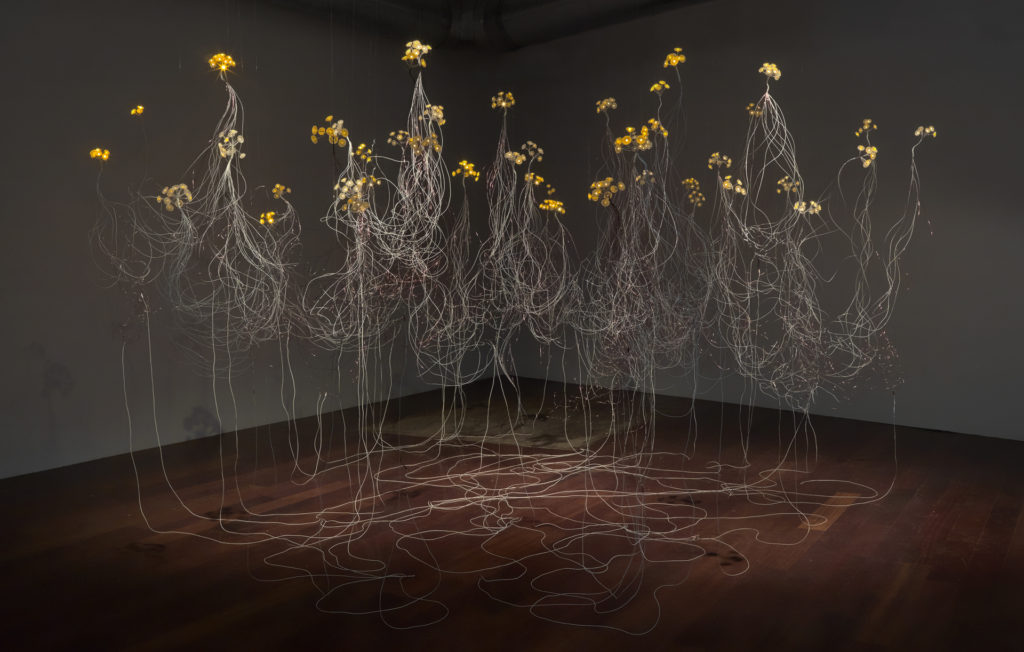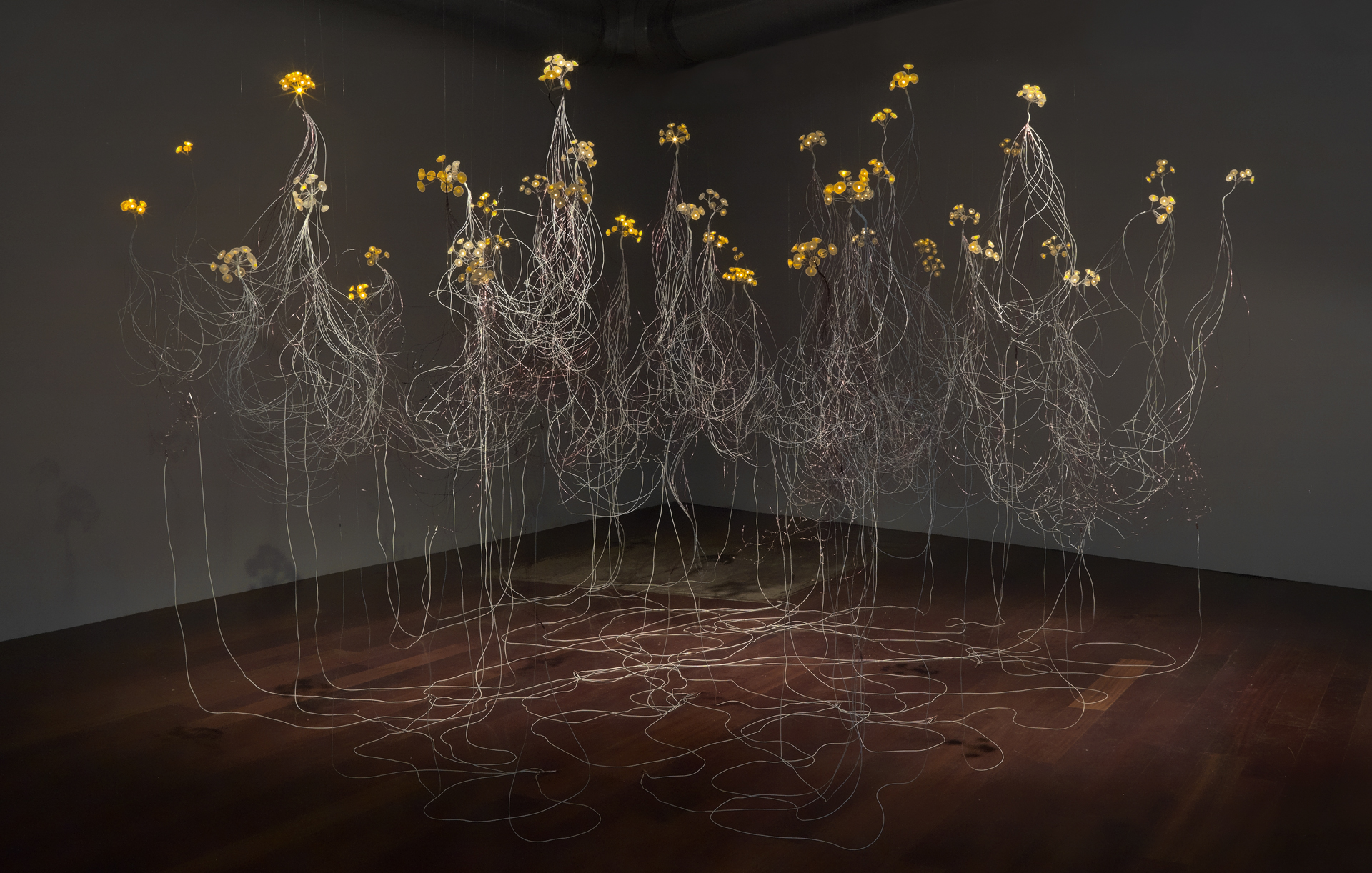
(Beth Galston’s magical “Luminous Garden Aerial”)
By Betsy DiJulio
The best thing to do when Gayle Paul is afforded the opportunity to curate a show her way is to not ask questions or debate whether it will be worth your time and simply go see it. At the very least, you can expect an elegantly installed and expertly lit array of work. But it won’t just be any work that happened to fit a theme; it will be thoughtful, intelligent selections that create a resonance far beyond the visual.
Such is the case with the current exhibition at the Portsmouth Art and Culture Center, Horizons: As Above, So Below, conceived in response to a request to mount an exhibition in celebration of the 99th Annual Meeting of the Garden Club of Virginia, hosted by the Elizabeth River Garden Club in Portsmouth this May. “This is not at all what I expected,” Gayle recounts one of the members exclaiming upon seeing the show.
I bet it wasn’t. But she meant it in a “good way.” Nothing against garden clubs and all of the truly good, charitable and environmental work they do, but a garden club show conjures up, in my mind, fairly realistic paintings of flowers in vases. Pretty? Sure. Ho-hum? Probably. But that is not how Paul rolls. Since she began searching for artists to include, she was driven largely by media, that is, artists exploring flora and organic structures in glass, ceramics, book-making and even installation work in addition to painting and photography. But also ideas.
The rectangular cube with its gleaming black floors that is the second story gallery of the Center is malleable in Paul’s hands. Somehow she managed to install substantial bodies of work by a dozen artists—two of whom work together collaboratively—from across the region and the U.S. in a way that allowed each their due, establishing site lines that celebrate each artist’s work without undue interference from surrounding pieces. In the process, she facilitated engaging visual and conceptual dialogues between the artists whose work, taken together, is assertively divergent.
The most realistic approaches to flowers are represented by master gardener Lynne Frailing’s large botanical illustrations that mine detail and nuance via watercolor and ink, feeding her curiosity and allowing her to share with viewers her close observation that marries botanical science and artistry.
Collaborators since 1979, John Littleton (whose father was Harvey Littleton) and Kate Vogel are third generation Studio Glass Movement artists who work in blown and cast glass, steel, and bronze from their studio in the mountains of North Carolina. Their work at the entrance to Horizons was inspired by the minimalistic grace and balance of Ikebana, duets of fluid line and form. Boat forms—vessels for the soul—inject a spiritual dimension.
Sepia-toned digital photographs on watercolor paper are Helen Jones’ micro-investigation of pods, mushrooms, leaves, and cones. Elegantly spare, they whisper of a vintage nostalgia. Having spent decades as a commercial photographer, her personal investigations progress in series that celebrate variations of form and texture through repetition.
The dense and richly colored nature-inspired compositions of Karen Rudd are admittedly personal and “self-indulgent” journeys of discovery. Her studio practice one of turning inward. She has been quoted as saying she nonetheless hopes her outward expression “touches on the universal.” Fecund presence and the presence of absence chart her path as she traverses the emotional terrain of life, love, and loss.
Karen Blair’s paintings afford viewers the opportunity to step back and take in a broader expanse of the natural world, largely referencing landscapes through her skillful use of the language of abstraction and near non-objectivity, here in a pastel palette.
Beth Glaston’s installation, “Luminous Garden,” possesses a magical quality of seeming symbiosis between the natural and technological worlds. Cast resin, LED lights, and delicate wires create a closed glowing system within a darkened space, hinting at the mystery of both realms.
The ceramic works of Barbara Kobylinska and Akiko Tanaka embody a more fanciful take on plant life, though their styles are worlds apart. Whereas Kobylinska’s brightly colored and boldly patterned large-scale plant forms exude a kind of cheerful exuberance, Tanaka’s forms, with their obsessive repetition and tensions of scale, seem to multiply in a way that is aggressively elegant, yet wild, untamed, and perhaps even delightfully sinister.
Emily Williams’ large scale, shimmering, vessel-like forms entitled “Sea Tangle” and “Pod” are made of clear, delicate, hand-torched borosilicate glass. They could almost be close-ups of one of Becky Stewart’s organic structures that populate her series of geometric wooden box-like panels. Veils of overlapping organic shapes and colors—with pops of the unexpected—combine with intricate, imaginative line work rendered in Mylar and sumi ink on the fronts, while precise geometric compositions in a compatible palette define the sides.
More pleasing geometry can be found in Nicole Pietrantoni’s, “Havened,” where the hand-made meets the machine-made. Her precise, orderly, geometric floor installation of nine accordion-style books is laid out in rows. Their folds create a rhythm of repeated triangular peaks in a striking palette of red-orange on the underside set-off against an image of a forest inkjet printed across the front in tones of cream, charcoal-brown, and deep, dusky blackish-teal.
Above, below. Inside, outside. Man, machine. Organic, geometric. This show will expand your horizons.
WANT TO VIEW?
Horizons: As Above, So Below
Through June 23
Portsmouth Art and Cultural Center
400 High Street, Olde Town Portsmouth
757. 393.8543 / Portsmouthartcenter.com




